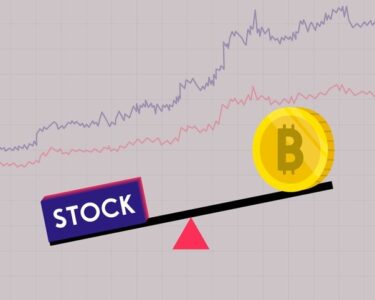Explore stock and crypto trading for profitable strategies and insights in this concise journey.
In the dynamic realm of financial markets, where fortunes shift in the blink of an eye, the ongoing debate between traditional stock trading and the modern world of cryptocurrency trading remains a focus for investors worldwide. Picture this: a seasoned stock trader, well-versed in the ins and outs of traditional markets, suddenly intrigued by the allure of decentralized digital currencies. On the flip side, a crypto enthusiast, navigating the volatile waves of the blockchain, contemplates the stability of established systems in the stock exchange.
This ongoing back-and-forth between these financial giants sets the stage for our exploration into the core of the matter: “Stock Trading vs. Crypto Trading: Profit Showdown.” As we embark on this journey, our focus centres on a crucial question: which path offers superior profitability? Join us as we dissect both realms, examining historical performances, evaluating risks, and providing tools to navigate these exciting yet unpredictable landscapes. Whether you’re an experienced investor or a curious newcomer, the following pages promise a nuanced exploration into the profit potential of stock and crypto trading, guiding you toward informed decisions. The stage is set, and the spotlight is on – let the Profit Showdown begin.
Understanding Stock Trading
Trading stocks involves buying and selling shares of ownership in companies via stock exchanges. Investors buy stocks hoping their value will rise over time, allowing profitable selling. Here’s an overview of the fundamentals and critical aspects of stock trading:
Basics
• Shares: Stocks represent ownership and are divided into shares.
• Stock Exchanges: Trading happens on exchanges like the New York Stock Exchange (NYSE) or NASDAQ.
• Brokerage Accounts: Investors use brokerage accounts, managed by online or traditional brokers, to trade stocks.
How It Works
1. Research: Investors analyze company performance, financial reports, and market trends for informed decisions.
2. Buying and Selling: Using brokerage platforms, investors place buy or sell orders at agreed-upon prices.
3. Market Dynamics: Stock prices change due to supply and demand, economic indicators, and company news.
Pros and Cons
Pros:
1. Historical Returns: Stocks historically yield higher returns compared to many other investments.
2. Diversification: Stocks allow portfolio diversification across various industries.
3. Dividend Income: Some stocks pay dividends, providing regular income to investors.
Cons:
1. Market Volatility: Stock prices can swiftly and unpredictably fluctuate.
2. Market Timing: Successful trading demands accurate timing, which is challenging.
3. Risk of Loss: Investments are prone to market changes, risking capital loss.
Factors Affecting Profitability
• Economic Indicators: GDP growth, inflation, and interest rates influence stock prices.
• Company Performance: Financial health and performance impact stock prices.
• Market Sentiment: Investor perception and news affect short-term prices.
Stock trading offers potential returns but carries risks. Understanding basics, involved parties, and profitability factors is vital for informed stock market decisions.
Overview of Crypto Trading
Crypto trading involves the exchange of digital assets or cryptocurrencies across various financial markets. Unlike traditional stock trading, it operates in a decentralized environment, leveraging blockchain technology. The key participants in this field include individual traders, institutional investors, and cryptocurrency exchanges.
How it Works
• Blockchain Technology: Cryptocurrencies rely on blockchain, a secure ledger that records transactions across a network of computers.
• Exchanges: Trading occurs on specialized online platforms known as exchanges, facilitating the buying and selling of various digital assets.
• Wallets: Traders use digital wallets to securely store their cryptocurrencies, which can be online, offline (hardware wallets), or mobile applications.
• Trading Pairs: Cryptocurrencies are traded against other cryptocurrencies or traditional fiat currencies. For instance, Bitcoin can be traded against the US Dollar (BTC/USD) or Ethereum (BTC/ETH).
Pros and Cons
Pros:
• 24/7 Market: Crypto markets operate around the clock, allowing traders to engage at any time, unlike traditional stock markets with set trading hours.
• Decentralization: Cryptocurrencies aren’t controlled by any central authority, offering financial autonomy and reducing government interference risks.
• High Volatility: Despite risks, high volatility presents opportunities for significant profits in short periods.
Cons:
• Volatility: High volatility can lead to substantial losses, making crypto trading riskier than traditional stock trading.
• Security Concerns: Exchanges and wallets are susceptible to hacking and fraud, posing risks for traders.
• Market Immaturity: The cryptocurrency market is relatively young compared to traditional ones, influenced by speculation and market sentiment.
Factors Affecting Profitability
I. Market Sentiment
• News and Events: Positive or negative news, regulatory developments, or security breaches can significantly impact cryptocurrency prices.
II. Technology and Innovation
• Blockchain Developments: Advances and new cryptocurrencies can influence the market, affecting the profitability of existing assets.
III. Regulatory Environment
• Government Regulations: Changes in regulations can impact the legality and acceptance of cryptocurrencies, affecting investor confidence.
IV. Adoption and Community
• Mass Adoption: Increased real-world applications and user base can positively impact the value of cryptocurrencies.
Crypto trading presents distinct opportunities and challenges. Understanding its basics, mechanics, and profitability factors is crucial for traders navigating this dynamic market.
Profitability Comparison: Stock Trading vs. Crypto Trading
In the quest for wealth creation, both stock trading and crypto trading stand out as significant avenues. Though both involve buying and selling assets with the aim of making a profit, they differ in their mechanisms, risks, and potential returns.
Historical Performance
Stocks
Stock markets have shown a long-term upward trend, with an average annual return of approximately 10% over the past century. This consistent growth is driven by economic expansion, corporate innovation, and dividend payouts. However, stocks aren’t immune to volatility, facing occasional crashes and recessions that impact investor returns.
Cryptocurrencies
Cryptocurrencies, like Bitcoin, have a shorter but more volatile track record. Bitcoin, for instance, rose from a few cents in 2009 to over $20,000 in 2017, only to drop to around $3,000 in 2018. This volatility attracts both risk-averse and thrill-seeking investors, each eyeing the market’s potential for significant gains.
Volatility
Volatility measures a market’s price fluctuations over time. Stocks, prone to occasional downturns, have historically displayed stability, making them a predictable choice for long-term investors. Cryptocurrencies, on the other hand, are highly volatile, with prices swinging wildly. While this volatility can lead to substantial profits for accurate predictors, it also poses a significant risk for those misjudging the market’s direction.
Case Studies or Examples
Stock Trading
Warren Buffett, the renowned investor and Berkshire Hathaway CEO, showcases the long-term profitability of stock trading. Over his career, Buffett turned an $11,495 investment into a staggering $83.5 billion. His success lies in his value investing philosophy, identifying undervalued stocks with strong fundamentals.
Crypto Trading
The pseudonymous investor “Satoshi Nakamoto” created Bitcoin, initiating the cryptocurrency revolution. While Nakamoto’s identity remains a mystery, their impact on finance is undeniable. Pioneering decentralized digital currency, Nakamoto opened doors to a new era of investment opportunities.
The choice between stock and crypto trading hinges on an individual’s risk tolerance, investment goals, and market understanding. Stock trading offers potential steady, long-term growth, while crypto trading presents the chance for rapid, exponential gains with higher risk.
Risks and Challenges
Market Risks
Investing in stocks or cryptocurrencies involves risks, and it’s vital for investors to understand the potential for significant losses in both markets.
Stock Market Risks
• Market Volatility: Stock prices can change rapidly due to economic news, company performance, and investor feelings. This volatility can result in substantial losses if investors misjudge the timing.
• Market Cycles: The stock market moves through cycles of growth (bull markets) and decline (bear markets). Bull markets see rising prices and investor optimism, while bear markets have falling prices and pessimism. These cycles can affect profits.
• Company-Specific Risks: Individual stocks can carry risks linked to the success or failure of the underlying company. Issues like poor management, product failures, or industry challenges can lead to big losses for investors holding those stocks.
Cryptocurrency Market Risks
• High Volatility: Cryptocurrencies often experience extreme price swings in short periods, causing significant losses for unprepared investors.
• Regulatory Uncertainty: Cryptocurrency markets lack the same level of regulation as traditional finance, leading to price fluctuations and potential instability due to uncertainty.
• Security Risks: Cryptocurrencies are vulnerable to security breaches and hacking, risking the loss of investor funds. Evaluating the security measures of exchanges and wallets is crucial before investing.
External Factors
Apart from market risks, external factors also influence both stock and crypto trading, affecting profitability.
External Factors Affecting Stock Trading:
• Economic Conditions: The overall economy significantly impacts stock market performance. A strong economy boosts investor confidence and stock prices, while a weak economy can dampen sentiments and lower prices.
• Geopolitical Events: Major events like wars or political unrest create uncertainty and volatility in the stock market, affecting investor sentiments and prices.
External Factors Affecting Crypto Trading:
• Regulatory Developments: Changes in regulations by governments or financial institutions impact the cryptocurrency market. New regulations may make purchasing or trading cryptocurrencies more challenging, reducing demand and prices.
• Public Perception: Wider acceptance and use of cryptocurrencies can raise their value, while negative public opinion can lower demand and value.
Both stock and crypto trading involve risks. External factors like economic conditions, geopolitical events, regulations, and public perception significantly influence profitability in these markets. Investors should carefully assess these risks before entering either market.
Tips for Successful Trading
1. Strategies for Stock and Crypto Trading:
In stock trading, look into a company’s financial health and market position using fundamental analysis. Additionally, consider technical analysis, which focuses on price charts and indicators for entry and exit points. For crypto trading, understand the technology behind a cryptocurrency, analyze market sentiment, and use tailored technical analysis due to the market’s volatility.
2. Diversification: Managing Risks in Both Markets:
Diversifying your investment portfolio is crucial in both stock and crypto trading. Spread investments across various stock sectors to reduce vulnerability to industry-specific risks. In crypto, diversify among different cryptocurrencies to avoid reliance on a single asset. A diverse portfolio can offset losses in one area while benefiting from gains in another.
3. Staying Informed: A Key to Success:
Financial markets are dynamic and influenced by various factors. Stay informed by following reputable financial news sources, market analysis, and updates from regulatory bodies. For crypto traders, monitoring technological advancements, regulatory changes, and community sentiment is essential. Being well-informed facilitates timely decision-making and a deeper understanding of potential market shifts.
The bottom line
In the faceoff between stock and crypto trading, success relies on savvy decision-making and smart strategies. Whether in the traditional stock world or the ever-changing crypto sphere, traders need solid plans. Diversifying investments safeguards against unexpected risks, making your portfolio stronger. Staying informed is crucial for ongoing success, letting traders adjust to market shifts and make wise choices. Ultimately, in the profit showdown between stocks and cryptocurrencies, a balanced approach and these key tips can give traders the confidence and strength to tackle both markets with resilience.



